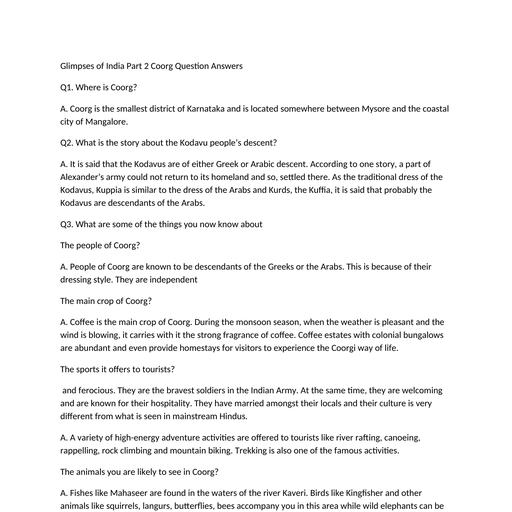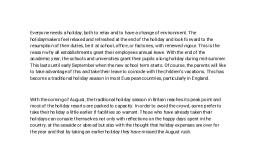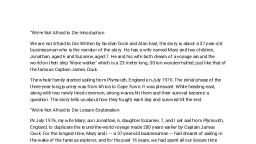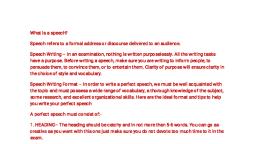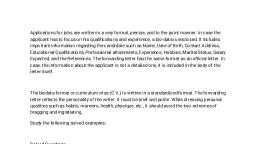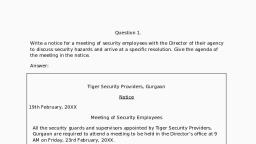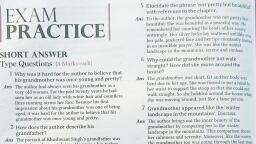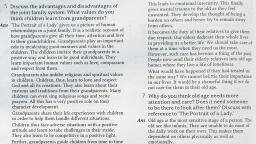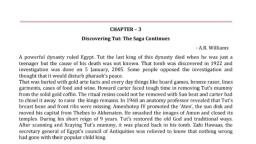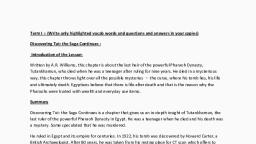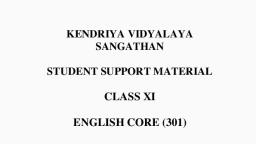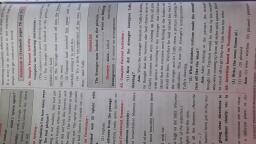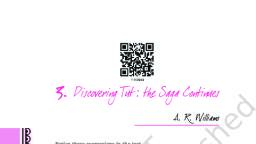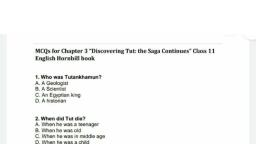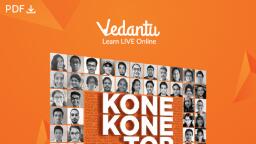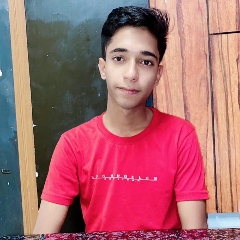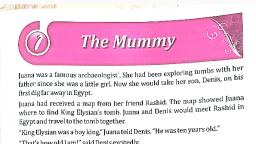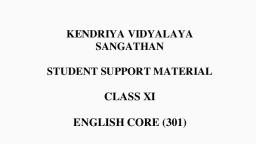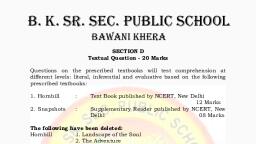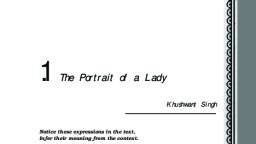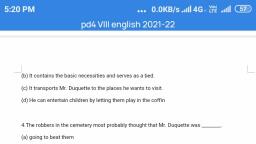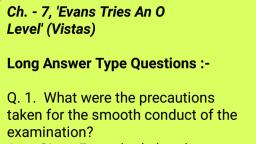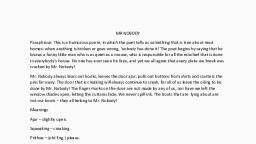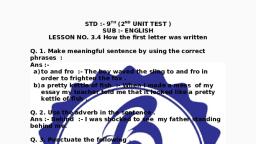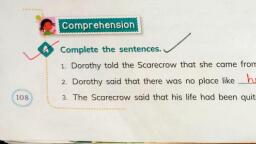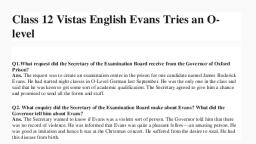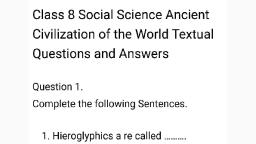Page 1 :
Discovering Tut: the Saga Continues Summary, , Discovering Tut: the Saga Continues is a chapter which gives us an in-depth insight of Tutankhamun, the, last ruler of the powerful Pharaoh Dynasty in Egypt. He was a teenager when he died and his death was a, mystery. Some speculated that he was murdered. He ruled in Egypt and its empire for centuries. In 1922,, his tomb was discovered by Howard Carter, a British Archaeologist. After 80 years, he was taken from his, resting place for CT scan which offers to solve the mystery of his life and death by creating a forensic, reconstruction., , Tut's father or grandfather, Amenhotep III, was a very powerful Pharaoh who ruled over a period of forty, years. His son, Amenhotep IV, thrived him and began the strangest period in the history of Egypt. He, promoted the worship of Aten (the sun disk). He changed his name to Akhenaten meaning servant of the, Atens. He also moved the religious capital from Thebes to the new city of Akhenaten, called Amarna., Further, he attacked Amun, a god, smashed his images and closed his temples. Another mysterious ruler, succeeded him who died soon. Next, Tutankhamun, also known as Tut, sat on the throne and ruled for, nine years. He worshipped god Amun in the old ways. However, he died mysteriously., , When Tut's mummified body was discovered, he was laid with lots of gold, wealth and everyday items like, a bronze razor, games, clothes, cases of food and wine. Carter discovered him after searching for many, years. After researching on the treasures, he decided to investigate his three nested coffins. Some parts, of the Tut's treasures in the tomb were already looted., , His tomb was rock-cut, 26 feet underground, which had wall paintings. On the outer coffin, Tut's face was, gilded. In the first coffin, he found the garlands of olives, lotus petals, and cornflowers. It showed that he, was buried in the months of March or April. The third and final coffin put Carter into trouble. The resins, used to cement Tut to the bottom of the solid gold coffin was hardened enough making it impossible to, move. He put the coffin in the sun for several hours in hope for the resins to loosen up but it didn’t work., Finally, he removed the resins with the help of chisel and hammer. Carter felt he didn’t have any other, choice as to if he hadn't cut the mummy from limb to limb, thieves would have looted the gold. His men, first removed his head, then they cut off every joint. After removing the body parts, they placed it on the, layer of sand in a wooden box and put it at the original place., , In 1968, the mummy was X-rayed by an anatomy professor, revealed few facts — his breast bone and, front ribs were missing., , Later, on January 05 2009, Tut was taken for CT (Computed Tomography) scan which takes hundreds of, X-Rays and creates a three-dimensional image. The night of the scan, the workmen carried his body from, the tomb in a box. They climbed ramp and stairs and lifted it on a hydraulic trailer that held the scanner., The scanner stopped working which paused the procedure. After using a pair of spare fans, the scan was, finally done. After three-hours, his body was taken back to his tomb where his body is resting in peace., , V7 | Edit with WPS Office
Page 2 :
Discovering Tut: the Saga Continues A.R. Williams, , He was just a teenager when he died. The last heir of a powerful family that had ruled, Egypt and its empire for centuries, he was laid to rest laden with gold and eventually, forgotten. Since the discovery of his tomb in 1922, the modern world has speculated, about what happened to him, with murder being the most extreme possibility. Now,, leaving his tomb for the first time in almost 80 years, Tut has undergone a CT scan that, offers new clues about his life and death — and provides precise data for an accurate, forensic reconstruction of the boyish pharaoh., , Saga — long story of a series of happenings, , Teenager — between 13 and 19 years, , Heir — Inheritor, successor, , Laden - loaded, , Speculated- form a theory without evidence, , Tomb- an enclosure to bury the dead, , Forensic Reconstruction — the process of recreating the face of an individual, Pharaoh- a ruler in ancient Egypt, , Tutankhamun, also known as Tut, was a teenager when he died. He was the last, successor of his powerful Pharaoh Dynasty which ruled Egypt and its empire for centuries., He was laid on rest, heavily loaded with gold. His tomb was discovered in 1922 which, made the world raise a question about what had happened to him and whether he had, been murdered? After almost 80 years, his body was about to undergo a CT scan which, would give new information and clues about his life and death. His face would be, , recreated with the help of a procedure called forensic reconstruction., , AN angry wind stirred up ghostly dust devils as King Tut was taken from his resting place, in the ancient Egyptian cemetery known as the Valley of the Kings*. Dark-bellied clouds, had scudded across the desert sky all day and now were veiling the stars in casket grey. It, was 6 p.m. on 5 January 2005. The world’s most famous mummy glided head first into a, CT scanner brought here to probe the lingering medical mysteries of this little understood, young ruler who died more than 3,300 years ago., , Stirred - move or cause to move slightly, , Ghostly — eerie and unnatural; unreal, , Resting place- here, the grave, , Cemetery- a large burial ground, , Dark-bellied - dark in colour, , Scudded across — moving quickly; it refers to the movement of the dark-bellied clouds, Veiling — to cover something, , Casket- a small ornamental box or chest for holding jewels, letters, or other valued objects., Casket grey — It means that the grey clouds were like a grey coloured casket which, contained the stars. The stars are like jewels which are kept in a casket., , Mummy - a preserved dead body, Glided — quite, continuous motion, Probe - to investigate, find out, Lingering — long-lasting, , A fast, strange and unnatural wind was blowing as King Tut's body was taken from his, , V7 | Edit with WPS Office
Page 3 :
grave called ‘Valleys of the Kings’, an ancient Egyptian cemetery (The location of the, Valley of the Kings is given in the image). Dark clouds moved quickly across the desert all, day long and later, they covered the stars. On January 5, 2005, at 6 pm, King Tut’s mummy, which is the world’s most famous mummy was placed in the CT scanner to investigate, the mystery behind his death which had occurred more than 3300 years ago., , All afternoon the usual line of tourists from around the world had descended into the, cramped, rock-cut tomb some 26 feet underground to pay their respects. They gazed at, the murals on the walls of the burial chamber and peered at Tut's gilded face, the most, striking feature of his mummy-shaped outer coffin lid. Some visitors read from, guidebooks in a whisper. Others stood silently, perhaps pondering Tut's untimely death in, his late teens, or wondering with a shiver if the pharaoh’s curse — death or misfortune, falling upon those who disturbed him — was really true., , Descended — moved or gathered, , Cramped — very small to fit into, , Rock-cut - made in a rock by cutting it, , Gazed — to look in surprise or in admiration, , Murals — a painting or other artwork executed directly on the wall, Gilded - covered with a thin sheet or coating of gold, , Striking- prominent, , Whisper- to speak in a low voice, , Pondering - think about something carefully, , All afternoon, tourists visited the 26 feet deep, underground rock-cut tomb to pay respect, to the king. Mnay people stuffed into the small tomb and looked in admiration at the, murals on the walls of the chamber and took a look at the face of Tut that had been, painted with gold. While visitors read the guidebooks in a hushed tone, some stood, silently, wondering about his untimely death in his teen years. They might also be, wondering if the curse of the pharaoh which leads to the descend of misfortune upon the, person who disturbs him is true., , “The mummy is in very bad condition because of what Carter did in the 1920s,” said Zahi, Hawass, Secretary General of Egypt's Supreme Council of Antiquities, as he leaned over, the body for a long first look. Carter—Howard Carter, that is — was the British, archaeologist who in 1922 discovered Tut's tomb after years of futile searching. Its, contents, though hastily ransacked in antiquity, were surprisingly complete. They remain, the richest royal collection ever found and have become part of the pharaoh’s legend., Stunning artefacts in gold, their eternal brilliance meant to guarantee resurrection, caused, a sensation at the time of the discovery — and still get the most attention. But Tut was, also buried with everyday things he'd want in the afterlife: board games, a bronze razor,, linen undergarments, cases of food and wine., , Archeologist — a scientist who studies ancient objects dug up from the ground, , Futile — pointless; incapable of producing the result of something, , Legend — an old story handed down through generations, , Hastily — fast; swiftly, , Ransacked - raid; go through a place to steal or damage something, , Antiquity - age, oldness, , Artefacts — objects of art made by hands, , Resurrection — restoration to life, , V7 | Edit with WPS Office
Page 4 :
Afterlife- life after death, based on the belief that the essential part of an individual's, identity continues to the next life after the death of the physical body, , Board games — games like chess, , Linen — a fabric cloth made from flax used to make high quality clothes, , Cases — boxes, , As Zahi Hawass, Secretary General of Egypt, leaned over the body to have a look, he said, that the mummy was in a very bad condition because of what the British archaeologist, Howard Carter did to it in the 1920s. He discovered King Tut's tomb in 1922 after a long, search. The valuable treasures of Tut had been explored earlier too but surprisingly, they, were complete. The treasure found at Tut's grave is the richest till date and has come to, be known as the Pharaoh's legend. It has artefacts in gold which are eternally beautiful, and as good as new. Such artefacts still get attention. Tut was buried with things of daily, use like a razor made of bronze, games, linen undergarments and boxes of food and wine, which he could use in the next life., , After months of carefully recording the pharaoh’s funerary treasures, Carter began, investigating his three nested coffins. Opening the first, he found a shroud adorned with, garlands of willow and olive leaves, wild celery, lotus petals, and cornflowers, the faded, evidence of a burial in March or April. When he finally reached the mummy, though, he ran, into trouble. The ritual resins had hardened, cementing Tut to the bottom of his solid gold, coffin. “No amount of legitimate force could move them,” Carter wrote later. “What was to, be done?”, , Funerary Treasures — the valuable things with which the king was buried, , three nested coffin- three cofins placed one in another in order of decreasing size. The, innermost coffin houses the body of the deceased., , Shroud — a length of cloth in which a dead person is wrapped, , Adorned — decorated, , Garlands of willow — a wreath of flowers and leaves, , Wild celery — a wild plant, , Cornflowers — bluish-purple flowers of a wild plant, , Mummy- a body of a human being or animal that has been ceremonially preserved by, removal of the internal organs, treatment with natron and resin, and wrapping in bandages., Ritual - here, the resins used in the ceremony of mummification, , Resins — a sticky flammable substance that is insoluble in water, , Legitimate - reasonable, , Carter took a few months to record the treasures found in Tut’s grave. Then he began, investigating his three coffins which were nested one in another. In the first coffin, he, found a piece of cloth with garlands of willow, olive leaves, wild celery, lotus petals and, cornflower, which suggested that he had been buried in the months of March or April., When he reached the third coffin, he was in trouble. The body had hardened due to the, resins which had cemented the body and it had stuck to the bottom of the coffin which, was made of gold. Carter wondered what to do next because no amount of force could, separate the two., , The sun can beat down like a hammer this far south in Egypt, and Carter tried to use it to, loosen the resins. For several hours he set the mummy outside in blazing sunshine that, , V7 | Edit with WPS Office
Page 5 :
heated it to 149 degrees Fahrenheit. Nothing budged. He reported with scientific, detachment that “the consolidated material had to be chiselled away from beneath the, limbs and trunk before it was possible to raise the king's remains.”, , Blazing - very hot, Budged — moved or shifted; a slight movement, Chiselled away — to cut something or separated with a chisel, , Carter tried to loosen the resins by keeping the body in the hot sun. He kept the mummy in, 149 degrees Fahrenheit heat for several hours but still, it remained stuck. He reported that, a chisel could be used to cut down the mummy from the limbs and the trunk so that Tut’s, body could be taken out of the coffin., , In his defence, Carter really had little choice. If he hadn't cut the mummy free, thieves, most certainly would have circumvented the guards and ripped it apart to remove the gold., In Tut's time the royals were fabulously wealthy, and they thought — or hoped — they, could take their riches with them. For his journey to the great beyond, King Tut was, lavished with glittering goods: precious collars, inlaid necklaces and bracelets, rings,, amulets, a ceremonial apron, sandals, sheaths for his fingers and toes, and the now iconic, inner coffin and mask — all of pure gold. To separate Tut from his adornments, Carter's, men removed the mummy's head and severed nearly every major joint. Once they had, finished, they reassembled the remains on a layer of sand in a wooden box with padding, that concealed the damage, the bed where Tut now rests., , Circumvented - find a way around; thieves would have found a way to tackle the guards, and remove the gold from the tomb, , Inlaid - a decorative pattern on a surface, , Collars — necklaces, , Bracelets — ornaments of the rich, , Amulet - an ornament or small piece of jewellery thought to give protection against evil,, danger, or disease., , Apron - a protective garment worn over the front of one's clothes and tied at the back., Sheaths — a close-fitting cover to keep the sword in, , Iconic - something or someone who is a symbol or it represents some other thing, Adornments — items used for decoration and make-up, , Concealed- hid, , According to Carter, he had no choice other than to cut the mummy. He believed that if he, hadn't done that, thieves would have removed the gold from the tomb and would have, looted it. During Tut’s time, the royal people were very wealthy and they had a belief that, after death, they could take the wealth along with them. For his life after death, he was, given precious collars, necklaces with decorative patterns, bracelets, rings, amulets,, ceremonial aprons, sandals, sheaths for fingers and toes and now, an iconic inner coffin, and a mask. His men removed his head and every joint of his body. After they finished,, they reassembled the remains in a wooden box with padding filled with a layer of sand to, conceal the damage. It was his new resting place., , Archaeology has changed substantially in the intervening decades, focusing less on, treasure and more on the fascinating details of life and intriguing mysteries of death. It, also uses more sophisticated tools, including medical technology. In 1968, more than 40, years after Carter's discovery, an anatomy professor X-rayed the mummy and revealed a, startling fact: beneath the resin that cakes his chest, his breast-bone and front ribs are, , V7 | Edit with WPS Office
